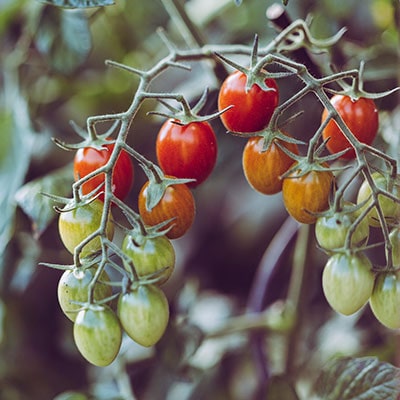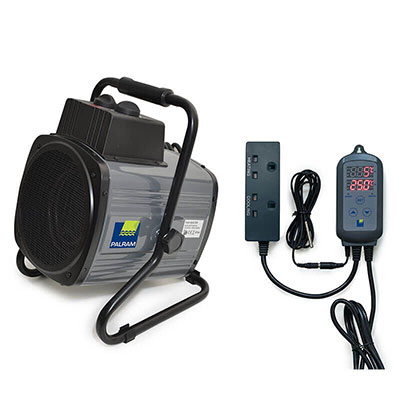
Owning a greenhouse extends the growing season, making it an invaluable asset to any gardener.
A wide range of produce can be grown in a greenhouse but it’s important to understand which crops to plant at different times of the year.
This seasonal greenhouse gardening guide explains what to grow, when to plant it and how to maintain your greenhouse throughout the year.
Firstly, let’s talk about planning…
Greenhouse Planning
Using a greenhouse to grow fruit and vegetables requires organisation. This begins with measuring out and ensuring there is enough room for all of your planned greenhouse crops. Benches should provide plenty of space for seedlings of which many will be moved outside, making space for new greenhouse crops. Be sure to fully utilise containers, growing bags and greenhouse borders.
Use clean pots and trays as well as fresh, peat-free seed or multi-purpose compost. Plus, follow the instructions on the seed packets.
Once germinated, seedlings require light and warmth, which an unheated greenhouse may not have until about April. Consider heating a partitioned section of the greenhouse for the more tender plants. As soon as protected crops are sturdy and well-rooted, they can be planted in their final positions.
A Year in the Greenhouse
Late Winter to Early Spring

At this time of year, prepare your outdoor garden for the post-frost plantings and sow hardy plants in the greenhouse. This includes cabbage, celeriac, early leeks, lettuce, Brussels sprouts, onions and peas. The greenhouse is ideal for starting these vegetables, which can then be moved outside once the frosts have passed. For greater success, invest in a heated propagator. Tomatoes, peppers and other tender plants can be grown early in heated greenhouses too. In unheated greenhouses, it’s better to buy ready-grown tomato and pepper plants.
Winter maintenance involves keeping structures clean, fitting insulation as needed and ensuring thermostats are properly working.
Mid to Late Spring

This is the time to sow the fast-growing tender plants. These include squashes, pumpkins, courgettes, cucumbers, melons, French beans and sweetcorn. This will get them ready for planting outside in early summer. Again, a heated propagator will assist with germination. Now is also a good time to sow basil, ready for moving outside in summer.
Summer

Remove spent melon, French bean and cucumber crops, to be replaced by additional crops. Sow spicy salad leaves, lettuces and baby carrots. New potatoes can be planted in greenhouses for late autumn and Christmas crops.
Summer maintenance involves checking plants are properly watered daily, ventilating the greenhouse, shading gradually when necessary, hanging yellow sticky traps as an early pest warning and tying new growth into supports, as required.
Autumn in the Greenhouse

Remove all spent summer crops. Plant lettuces in beds or grow bags for harvest over winter. Parsley and French bean seedlings can be planted to mature indoors. Broad beans and peas can also be sown over-winter for planting out in early spring. Likewise, hardy lettuce cultivars and pea shoots can be sown for harvesting indoors in the spring. Finally, any herbs in pots that have been outdoors should be moved indoors to keep them cropping longer.
(To find out more about the best foods to grow in a greenhouse, click here.)
Full Greenhouse Maintenance
Autumn is the ideal time to complete full greenhouse maintenance.
Cleaning A Greenhouse

Choose a relatively warm, dry day and get everything out of the greenhouse. Wash all of the glazing and staging down with soapy water. Pay particular attention to the nooks and crannies, or anywhere bugs can hide. Let everything dry and then put your plants back inside. This will reduce the risk of plant diseases and maximise light levels.
Insulating A Greenhouse

If you can, put all your plants together on the staging in one half of the greenhouse. Choose the half away from the door. You can then put up a curtain of bubble plastic at the halfway point, in effect halving the length of your greenhouse. This will help keep heating costs down and your plants nice and snug.
The rest of the glazing can be insulated using bubble plastic. It’s easily fitted to both timber and metal framed greenhouses. The gap of air between the plastic and the glazing, along with the bubbles in the plastic itself, keep the greenhouse well insulated. A word of warning - if you use heaters in the greenhouse keep the plastic away from the heating elements. Also, if you are using the half of the greenhouse with the vent, ensure it still opens. We’ll talk more about vents in a bit.
Taking Care of Doors

Doors are leaky. Close your greenhouse door and examine the frame for gaps. Draught excluder made for house doors is easily cut to size and effective at blocking air movement. Wood filler can be used for more permanent and larger gaps. Extra beading or thin strips of wood will cover up any small gaps caused when older greenhouses slump. These are small measures but they will have a big impact.
Heating A Greenhouse
Heating is vital if you want to grow tender and exotic plants. A greenhouse will always be a couple of degrees warmer than the outside temperature (concrete floors act as radiators giving off heat and the air warms up quickly on sunny days). However, if it’s -5C outside chances are temperatures in the greenhouse will be down to -3 or so, and that can be fatal to many plants.
Heating is such a personal choice. Electric heaters are convenient, easily controlled and programmable. If you don’t want to incur the cost of hiring an electrician to connect the greenhouse to your electricity supply, you can use gas and paraffin heaters. If you opt for paraffin, remember to keep a fuel reserve to avoid it running out on the coldest night of the year.
(To learn more about greenhouse accessories, click here.)
Greenhouse Ventilation

Now, what about those vents? Just because it's cold outside doesn't mean your greenhouse doesn’t need ventilation. The temperature in a standard 6x8 greenhouse will rocket within a few hours, even on a sunny winter's day. Only a couple of weeks ago my own 6x8 boasted a 28C maximum temperature on what was a freezing day outside. So, your automatic vents need to be working freely. It will create a more regulated and healthier environment for your plants.
Of course, you’ll need to be able to monitor the temperature, so a maximum-minimum thermometer is essential. It will record the hottest temperature, how cold it plunged to, as well as the current reading. Perfect for ensuring your insulation and heating are both working well.
Get it clean, make it snug and your greenhouse will be a real asset in your garden.
Greenhouses for Sale
Whether you’d like to try greenhouse gardening for the first time or if you’ve decided to upgrade your existing greenhouse, view our fantastic range of greenhouses for sale.







